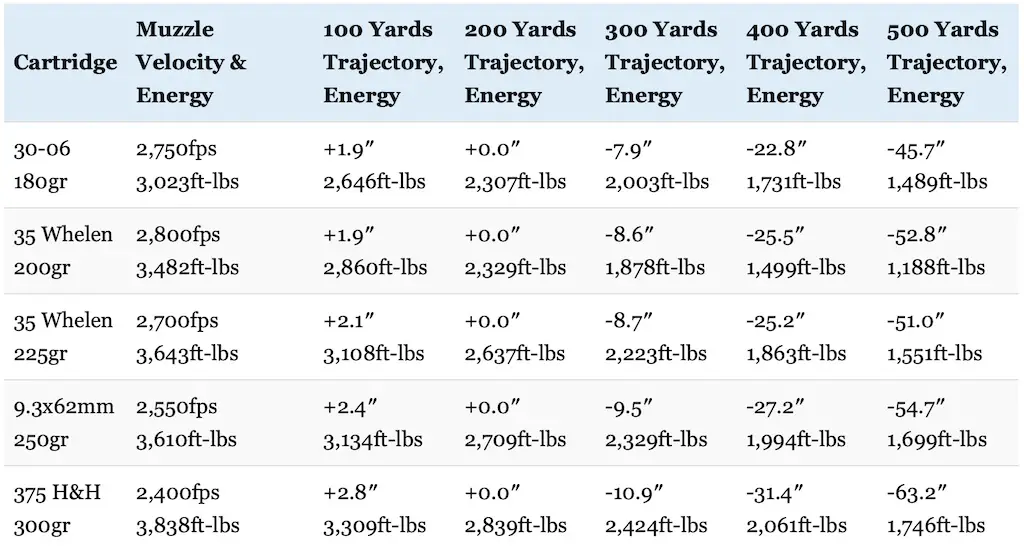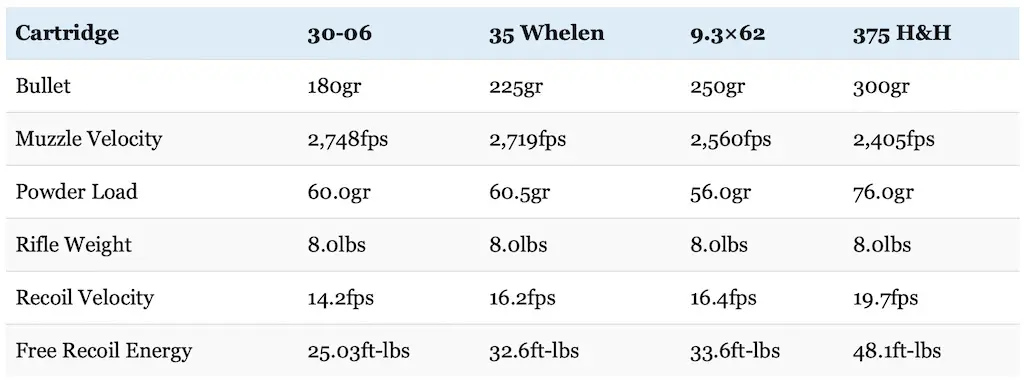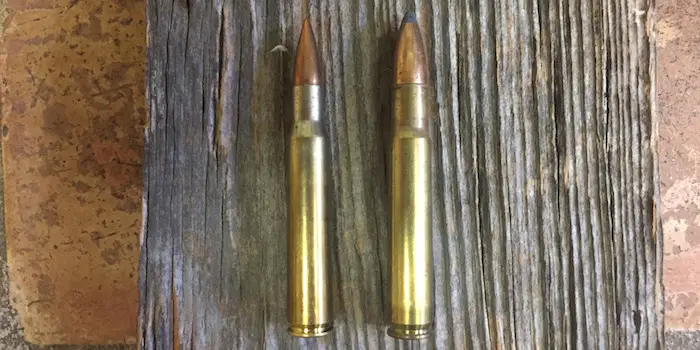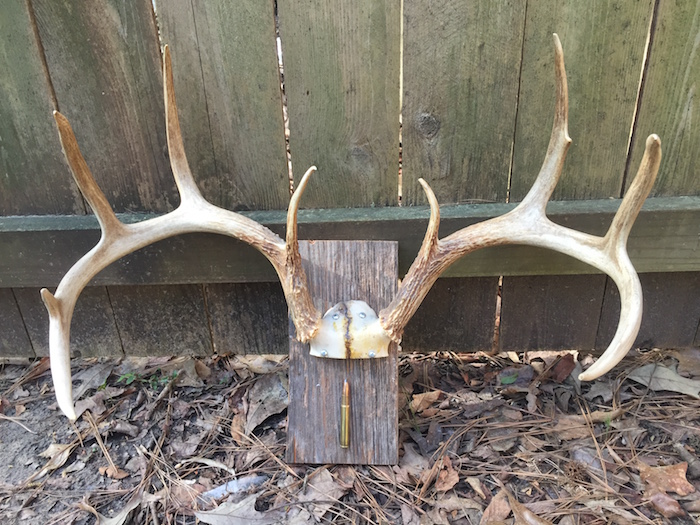Born in the early 1920s, the .35 Whelen is one of the most successful wildcat cartridges descended from the .30-06 Springfield.
Most hunters probably agree the legendary 30-06 Springfield is an outstanding all-around hunting cartridge. While it’s an excellent choice for many hunting uses, it’s not well suited to every single hunting situation. In fact, cartridges like heavy hitting the 35 Whelen handily outperform the old 30-06 in some areas.
Though not nearly as well known as the 30-06 Springfield, the 35 Whelen has been around for well over a century and is very highly regarded in some hunting circles. Like the 30-06, it is flexible enough for use on a variety of game in North America and elsewhere in the world. However, it has a big advantage in situations where hunters want a larger caliber and heavier hitting round.
In this article, I discuss the history as well as the strengths and weaknesses of the 35 Whelen in detail. I also provide some information on how the 35 Whelen compares to the venerable 30-06 as well as the 9.3x62mm Mauser and 375 H&H Magnum cartridges to give you an idea of what sort of performance you can expect from the cartridge and so you can decide if it best fits your needs as a hunter.
Note: some of the links below are affiliate links. This means I will earn a small commission (at no extra cost to you) if you make a purchase. This helps support the blog and allows me to continue to create free content that’s useful to hunters like yourself. Thanks for your support.
Additionally, I recorded an entire podcast episode on this exact subject. If you’d rather listen than read, click the appropriate link below to listen to this episode on your preferred podcasting service.
35 Whelen Podcast
Apple | Google | iHeart | Pandora | Spotify
.35 Whelen History
Colonel Townsend Whelen was one of America’s foremost gun writers and had a hand in designing a number of different rifle cartridges in the early 20th century. Of these, the .35 Whelen is probably the most famous and most widely used.
Interestingly enough, his role in designing the cartridge is disputed with many historians believing that James Howe (later of Griffin & Howe fame) designed the .35 Whelen and simply named it after Townsend Whelen.
Regardless of who exactly did most of the work designing this cartridge, Whelen is forever linked to it and it’s also pretty clear that whatever his involvement was in actually designing the 35 Whelen, Col Townsend Whelen was indeed a big booster of the cartridge similar to Jack O’Connor with the 270 Winchester.
In contrast to the exact origins of the cartridge, the design of the 35 Whelen is very simple and very clear: it’s a .30-06 Springfield case necked up to use .358″ instead of .308″ bullets (the exact opposite of the .270 Winchester in other words).
Common loads fire a 200-grain bullet at 2,800 fps (about 3,480 foot pounds of energy), a 225-grain bullet at around 2,600fps (3,380 foot pounds of energy), or a 250-grain bullet at approximately 2,500fps (3,470 foot pounds of energy).
It’s considerably more powerful than the .30-06 Springfield, but still fits in a standard length action with the same size bolt face as the .30-06. It also filled a gap that existed at the time between the .30-06 originally developed for the Army and the relatively expensive and difficult to obtain (back then) magnum cartridges like the .375 H&H.
Here’s an excerpt from p692 of Hornady’s 10th Edition Reloading Manual that emphasizes that point:
At the time of its introduction, a magnum Mauser action alone cost about the price of two complete domestic sporting rifles, and hunters wanting a rifle which would approximate the power of the big 375 H&H had to dig deep into their pockets to achieve their goal.
But the 35 Whelen gave hunters a fine low cost alternative; the cartridge was short enough to work through standard length (30-06) actions, conversion to the Whelen was simple, and cases could be made easily by running 30-06 brass over a 35 caliber expander plug. Though 35 Whelen performance falls several hundred feet per second short of 375 velocities with comparable bullets, the 35 Whelen is nevertheless a potent, accurate, and dependable medium to big game cartridge.
This is how the cartridge got the nickname “The Poor Man’s Magnum.”
It was easy to convert a Springfield Rifle (or any other 30-06 rifle) to the cartridge and the same was true with 30-06 brass, both of which were widely available in the USA. All you needed was some .358” diameter bullets, which were available as component bullets originally designed for some of the other 35 caliber rifle cartridges of the day like the 35 Remington.
Hunters particularly appreciated the effectiveness of the cartridge on large animals like moose and brown bear. While cartridges like the .45-70 Government were (and still are) valued for their effectiveness on these same animals, the .35 Whelen had several attributes that helped set it apart from other “big hitters” of the day.
First, the .35 Whelen has a relatively flat trajectory almost on par with the .30-06. Next, the cartridge also has very good terminal performance out to several hundred yards. Finally, it also has a surprisingly mild recoil.
That being said, notwithstanding the surprisingly large appeal of the cartridge, it was still a somewhat niche round. Most people outside of certain parts of Alaska, Canada, or the Rocky Mountain west don’t hunt really big creatures and cartridges like the 270 and 30-06 were perfect for use on deer, pronghorn, and black bear.
Additionally, there were pretty limited sources of ammunition and rifles resulting from the “wildcat” roots of the .35 Whelen which further restricted the appeal of the cartridge to a narrow segment of the population.
These factors, along with the “neither fish nor fowl” nature of .35 caliber cartridges in general, help explain why the cartridge never made it into more widespread use in the United States.
For many years, factory loaded ammunition was essentially nonexistent. At the same time, rebarreled Mausers or Springfields made up the vast majority of .35 Whelen rifles until the 1980s when Remington started producing factory ammunition as well as rifles chambered in the cartridge.
Remington has had some big “misses” over the years and really flubbed their rollout of otherwise well designed cartridges like the 260 Remington and 280 Remington.
However, the company does have a good track record of taking popular wildcats and legitimizing them. They did this with the 22-250 Remington, the 25-06 Remington, and the 7mm-08 Remington.
Well, they did that with the 35 Whelen as well and that’s a big part of the reason why the 35 Whelen is still hanging around today.
.30-06 Springfield vs .35 Whelen vs 9.3x62mm Mauser
So how does it stack up to other cartridges? Well, the .30-06 Springfield, 9.3x62mm Mauser, & 375 H&H Magnum are the three cartridges most often compared to the .35 Whelen.
The differences between the four cartridges are most apparent in the table below comparing 35 Whelen loads firing 200gr Federal Fusion (.343 BC) and 225gr AccuBond (.43 BC) bullets to Nosler Trophy Grade loads for the 30-06, 9.3×62, and 375 H&H firing 180gr AccuBond (.507 BC), 250gr AccuBond (.494 BC), and 300gr AccuBond (.485 BC) bullets respectively.
It’s important to realize here that the 200gr Fusion load for the 35 Whelen is pretty pedestrian load for that cartridge and uses a lower BC bullet. On the other hand, that 225gr AccuBond load represents something of a “best case” scenario for the cartridge with a pretty high BC bullet pushed at a velocity that’s near the upper bound of what the cartridge is capable of.

As you can see, though the .30-06 is no slouch, the .35 Whelen is significantly more powerful, particularly at close range. Those two 35 Whelen loads have 15-20% more kinetic energy at the muzzle.
That advantage does diminish as range increases (and even flips in favor of the 30-06 compared to the 200gr Fusion around 200 yards) because the 30-06 uses higher BC bullets. However, the 225gr 35 Whelen load maintains an advantage all the way out to 500 yards. And even the 200gr load has a pretty big edge inside 100-150 yards or so.
On the other hand, the .30-06 has a flatter trajectory than both 35 Whelen loads.
The .35 Whelen has a slightly flatter trajectory than the 9.3x62mm Mauser, but things are different in the energy department. The 9.3x62mm Mauser has a 3-4% edge over the 200gr 35 Whelen load in terms of muzzle energy, but the 225gr 35 Whelen load actually has a tiny bit more kinetic energy at the muzzle.
It’s not too much of an exaggeration to say the two cartridges are virtually twins ballistically.
Even the mighty 375 H&H load compared here only has around 5-10% more kinetic energy than the 35 Whelen loads shown here. And the 35 Whelen has an even more significant edge in terms of trajectory over the 375 than it does over the 9.3x62mm Mauser.
There are some other 375 H&H loads that deliver around 4,200ft-lbs of energy at the muzzle though. That works out to about a 15-20% advantage in favor of the 375 H&H.
Now let’s talk about recoil.
The table below compares the recoil produced by handloads that are very similar to the AccuBond loads compared above for the 30-06, 35 Whelen, 9.3x62mm Mauser, and 375 H&H when fired from identical rifles.

Felt recoil will vary from shooter to shooter and rifle to rifle, but free recoil energy is still a useful way to compare cartridges.
As you can see, the 35 Whelen has recoil virtually identical to the 9.3×62 Mauser, a little more recoil than the 30-06, and quite a bit less than the 375.
Many hunters can handle the recoil of all of these cartridges, but the .375 H&H usually represents the upper end of what the typical hunter can deal with. So, the 35 Whelen has a pretty significant edge in this respect and only has 20-30% more recoil than a typical rifle chambered in .30-06 Springfield.
Don’t underestimate the impact that recoil has on the ability of a person to shoot accurately either. Regardless of how well a given person handles recoil, all other things being equal, they will absolutely shoot better with a milder recoil.
Additionally, there are a couple of other factors that are also worth discussing.
First, the 35 Whelen uses larger diameter bullets than the 30-06 Springfield.
Specifically, the larger diameter .358 bullets used by the cartridge have about 35% more frontal surface area (also known as cross sectional area) than the .308″ bullets used by the 30-06 Springfield (.1007 vs .0745 square inches). All other things being equal, a bigger bullet will make a bigger hole, cause more tissue damage, and result in more blood loss.
This is a significant advantage in favor of the 35 Whelen, especially on bigger game.
It’s not quite on the level of the 9.3×62 or 375 H&H in this area though (their .366″ and .375″ bullets have ~4.5% and ~10% greater frontal surface area than the 35 Whelen respectively).
However, especially when combined with the fact that the 35 Whelen carries more kinetic energy downrange than the 30-06, those larger diameter bullets can also be helpful when hunting big game, especially on really big game like elk, moose, and the big bears.
What about the really big species of game though? Like cape buffalo and elephant?
This is where the 35 Whelen starts to fall short and where the 9.3×62 and especially the 375 H&H really start to shine.
Sure, it can be done (and I know people have cleanly killed both buffalo and elephant with the cartridge), but it’s really just a little too light for me to advocate using it for that work.
This is for a couple of reasons.
First, the 35 Whelen falls short of the legal energy and caliber requirements for hunting thick-skinned dangerous game in most African countries.
Details vary from country to country, but .375 is the minimum legal caliber for thick-skinned dangerous game in most African countries (Zimbabwe has a 9.2mm minimum, which the 35 Whelen just barely falls short of).
Furthermore, most countries also have a minimum muzzle energy requirement of around 4,000 ft-lbs to legally hunt thick-skinned dangerous game.
Once again, the exact details vary a little bit here.
For instance, Zimbabwe has a legal minimum energy of 5,300 Joules (3,909 foot pounds) for hunting “Class A” game like buffalo, hippo, and elephant. Namibia has a minimum energy requirement of 5,400 Joules (3,982 foot pounds) for hunting buffalo, elephant, and rhino.
The 35 Whelen comes close, but most factory loads still fall short of those marks. Interestingly, the wildcat 35 Whelen Ackley Improved does meet that minimum energy threshold and Mike Arnold used that cartridge to cleanly take a cape buffalo in Mozambique.
Finally, the 35 Whelen is a little lacking in bullet sectional density and falls short of the generally accepted minimum recommended bullet sectional density of .300 for use on thick-skinned dangerous game.
Sectional density (SD) is a measure of the ratio of the diameter of a projectile to its mass.
All other things equal, a heavier bullet of a given caliber will be longer and therefore have a higher sectional density and consequently penetrate deeper than projectiles with a lower mass and sectional density.
Well, 200 grain, 225 grain, and 250 grain .358″ bullets have sectional densities of .223, .251, and .279 respectively.
A 270gr .358″ bullet has a sectional density of .301, but those weight bullets are very unusual.
Swift does make a 280gr A-Frame in .358″ caliber (.312 SD), but that’s the only .35 caliber bullet in that weight range I’m aware of (at least among the big manufacturers).
That particular bullet would probably work pretty well on a cape buffalo though for someone who insisted on using the cartridge in that role.
With all that said though, the 35 Whelen was not designed for dangerous game hunting in Africa. No, it was designed to be a heavier hitting bigger brother to the 30-06 that was better suited for the really big and dangerous species of North American game and it absolutely excels in that role.
I would not hesitate one bit to use the 35 Whelen on brown or grizzly bear in Alaska or Canada. The same is true on elk, moose, or literally any species of African plains game.
The details are a little outside the scope of this article, but the 400 Whelen is the bigger brother to the 35 Whelen. While the 35 Whelen was designed from the start to excel on North American game, the 400 Whelen was intended for use on even bigger creatures like buffalo and elephant in Africa. Literally a 30-06 necked up to shoot .41 caliber bullets, the 400 Whelen is capable of launching a 400gr .4115″ caliber bullet (.337 SD) in excess of 2,150fps for about 4,100ft-lbs of muzzle energy.
Unfortunately, that cartridge suffered from some other problems that hampered widespread acceptance in the hunting community. Even so, that’s outstanding performance from a standard length cartridge with a standard bolt face and is probably delivering very close to the maximum performance achievable out of a package that size.

.35 Whelen Ammo
Thanks to legitimacy that Remington gave the cartridge in the 1980s, many of the major gun manufacturers now produce factory loaded .35 Whelen ammunition and most gun stores keep some in stock. For instance, Barnes, Federal, Hornady, Nosler, and Remington all manufacture at least one load for the cartridge.
200gr bullets are probably the most popular and easy to find and you can choose between the Barnes VOR-TX, Federal Fusion, Hornady Superformance, Remington Core Lokt, and Winchester Super X line-ups in this bullet weight.
At the same time, Barnes also produces a 180gr loads in their VOR-TX line-up, Nosler makes a load with their 225gr AccuBond, and Remington also produces a 250gr load in their High Performance Rifle line.
Some modern factory-loaded .35 Whelen ammo has slightly improved ballistics compared to the original loads from the 1920s. For instance, Hornady advertises a velocity of 2,910fps for their 200gr Superformance load.
Before .35 Whelen factory loads were widely available, handloaders were the primary source of .35 Whelen ammo. For this reason, there are still lots of quality .358 bullets in production like the 200gr Barnes TTSX, 225gr Barnes TSX, the 200gr Hornady FTX, 200gr Sierra Pro Hunter, the 250gr Swift-A-Frame, and the 225gr Sierra Game King.
BUY SOME EXCELLENT 35 WHELEN HUNTING AMMO HERE
BUY MORE GREAT 35 WHELEN HUNTING AMMO HERE
If you’d like to learn more about some of the various hunting ammunition choices for the 35 Whelen cartridge, read this article:
Best 35 Whelen Ammo For Hunting Elk, Deer, Bear, Hogs, & Other Game
.35 Whelen Rifles
Due to its wildcat roots, few American gun manufacturers made rifles chambered in .35 Whelen until the 1980s. The cartridge still remains almost unheard of outside the United States. Prior to Remington opening the door for large scale production of .35 Whelen rifles, virtually every rifle in existence chambered for the cartridge was some sort of custom conversion (primarily 1898 Mausers and 1903 Springfields).
However, .35 Whelen rifles are a lot easier to find now than they used to be. Remington has produced bolt-action Model 700, semi-automatic Model 750, and pump-action Model 7600 rifles chambered in the cartridge off and on over the years. The same is true with the Ruger No. 1 and Nosler M48, and Thompson/Center Encore.
The CVA Scout is the only rifle I’m aware of that’s currently manufactured in the cartridge. Adam Wiess (better known as WHO_TEE_WHO) took a great looking bison with that exact rifle in 35 Whelen back in 2022.
BUY AN EXCELLENT 35 WHELEN HUNTING RIFLE HERE
Hunting With The .35 Whelen
One of the reasons the .35 Whelen first became popular among American hunters was because it was so effective on really big species of North American game. That hasn’t changed and it remains a wonderful choice for grizzly/brown bear and moose hunting. If anything, the cartridge is even more effective on those animals now because of advances in bullet design. The .35 Whelen is also something of an underrated cartridge for elk hunting.
Additionally, it’s also a great cartridge for hunting medium sized game like whitetail deer, feral hogs, and black bear.

The same goes for most species of African plains game (like impala, kudu, wildebeest, waterbuck, zebra, and even eland) as well as animals that you’ll encounter on a New Zealand hunting safari like fallow deer, rusa deer, sika deer, sambar deer, or red stag.
The cartridge packs a heck of a punch and has a flat enough trajectory that it’s suitable for hunting most species of big game out to several hundred yards without too much trouble. Honestly, the only critters I don’t recommend using it on are extremely large species of African game like cape buffalo, elephant, and hippopotamus.
Though the .35 Whelen cartridge topped out well short of the top echelon of the most popular hunting cartridges like the .30-30 Winchester or the .30-06 in terms of popularity, it’s still great medium bore cartridge and is arguably one of the best .35 caliber cartridges ever made, especially considering that it does not require the use of a magnum bolt face or magnum length rifle action.
Say what you will about the .35 Whelen, but that cartridge has been a solid performer for nearly a century now with no end in sight.
While it’s not often thought of as a “classic” Africa hunting cartridge, the 35 Whelen can be darn effective on plains game. To that end, I recorded an entire podcast episode on classic Africa hunting cartridges with renowned Professional Hunter and author Kevin Robertson. In this episode, we talk about the pros, cons, and recommended uses for almost everything from the 243 Winchester all the way up to the 600 and 700 Nitro Express (to include the 35 Whelen).
This is a fantastic episode, so just click the appropriate link below to listen to our discussion on your preferred podcast app. Be sure to hit that “Subscribe” or “Follow” button in your podcast app to receive future episodes automatically (for free)!
Classic Africa Hunting Cartridges Podcast
Apple | Google | iHeart | Spotify
Do you have a .35 Whelen that you want to take on a hunt?
Book an excellent black bear hunt here.
Book an outstanding Africa hunting safari here.
The Lyman 50th Edition (p314-315) and Hornady 10th Edition (p692-694) reloading manuals were used as references for this article.
If you’d like to read a more detailed discussion on a cartridge that’s often compared to the .35 Whelen in the .358 Winchester, read this article:
338 Federal vs 308 Winchester vs 358 Winchester: What You Need To Know
Enjoy this article on the .35 Whelen? Please share it with your friends on Facebook and Twitter.
Make sure you follow The Big Game Hunting Blog on Facebook, Instagram, Twitter, and YouTube.
NEXT: READ THIS BEFORE HUNTING CAPE BUFFALO WITH THE .45-70 GOVERNMENT
John McAdams is a proficient blogger, experienced shooter, and long time hunter who has pursued big game in 8 different countries on 3 separate continents. John graduated from the United States Military Academy at West Point and is a veteran of combat tours with the US Army in Iraq & Afghanistan. In addition to founding and writing for The Big Game Hunting Blog, John has written for outdoor publications like Bear Hunting Magazine, The Texas State Rifle Association newsletter, Texas Wildlife Magazine, & Wide Open Spaces. Learn more about John here, read some of John’s most popular articles, and be sure to subscribe to his show: the Big Game Hunting Podcast.


The Whelen is my favorite caliber, i recetly converted a savage axis into a 35 whelen by just changing barrels, shoots lights out, but has considerable recoil due to light weight, and i purchaced a rem 750 in 35 whelen I use 225 sierra game kings for deer in wisconsin, they hit the ground faster then the gun comes down from recoil, great cartridge